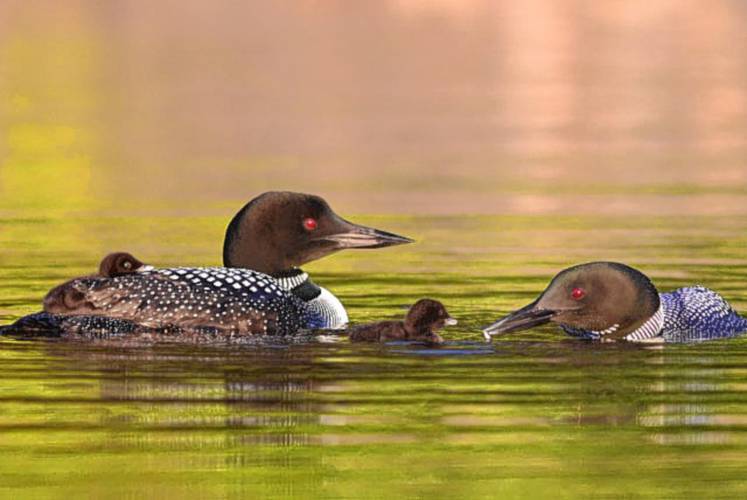Love, family and perilous surroundings return on Live Loon Cam
| Published: 06-17-2024 3:08 PM |
The most New Hampshire of real-life romances has returned to computer monitors as the Live Loon Cam from the Lakes Region heads into its 10th year.
The loon couple seen on Camera No. 2 laid their first egg Monday, with another expected this week.
“The members are banded, so we know they’re the same loons that were there last year. The female has come here since 2018; the male, this is his third year,” said Caroline Hughes, outreach biologist with the Loon Preservation Committee.
Loon pairs often stick together and return to the same nesting sites year after year, Hughes said. “They are creatures of habit.”
The Loon Cam, streaming live on YouTube from May through late June, is also notable for active discussions that go on among fans.
“People love to talk about what’s going on. They time-stamp cool things that happened, like another species coming through or birds turning an egg, so others can rewind back and see it,” Hughes said. “Many have been watching the cams for years and are very knowledgeable, and can help orient new viewers.”
The group’s biologists also join the discussion at times.
There’s also a loon couple currently nesting on Camera No.1, although they’re slightly behind in this year’s egg-laying race.
Article continues after...
Yesterday's Most Read Articles
 A Webster property was sold for unpaid taxes in 2021. Now, the former owner wants his money back
A Webster property was sold for unpaid taxes in 2021. Now, the former owner wants his money back
 ‘He died loving you’ — Jesse Sullivan sentenced in murder of half-brother Zackary
‘He died loving you’ — Jesse Sullivan sentenced in murder of half-brother Zackary
 Universal EFA program sees 2,000 applications in first week of expansion
Universal EFA program sees 2,000 applications in first week of expansion
 Webster seized and sold his house for back taxes. Now the town has agreed to pay him $38,000
Webster seized and sold his house for back taxes. Now the town has agreed to pay him $38,000
 Company C is closing its Concord store – but the company itself isn’t closing
Company C is closing its Concord store – but the company itself isn’t closing
The Loon Cams can be found by searching YouTube.com for Loon Preservation Committee, or via the group’s website at loon.org.
Loons are a migratory species. By the mid-1970s, fewer than 100 were returning to New Hampshire each year. Since then preservation efforts have more than tripled the nesting population, although it’s only about half of the number which can be easily supported in the state.
Threats to the birds range from lead tackle, which poisons them if accidentally swallowed, to getting tangled in lost fishing lines to development and even predation by the increasing population of bald eagles.
If a loon nest is found, it should be given plenty of space — 150 feet at minimum, and more if the loon shows signs of distress, such as lowering its head over the nest. If you accidentally flush a loon from the nest, leave the area immediately so that the loon can resume incubation.
Boaters are also urged to follow New Hampshire’s no wake laws in order to avoid swamping loon nests.
David Brooks can be reached at dbrooks@cmonitor.com.










 Concord’s two Rite Aid stores shutting soon
Concord’s two Rite Aid stores shutting soon From morning jokes to parental influence: Bow High Class of 2025 graduates
From morning jokes to parental influence: Bow High Class of 2025 graduates
